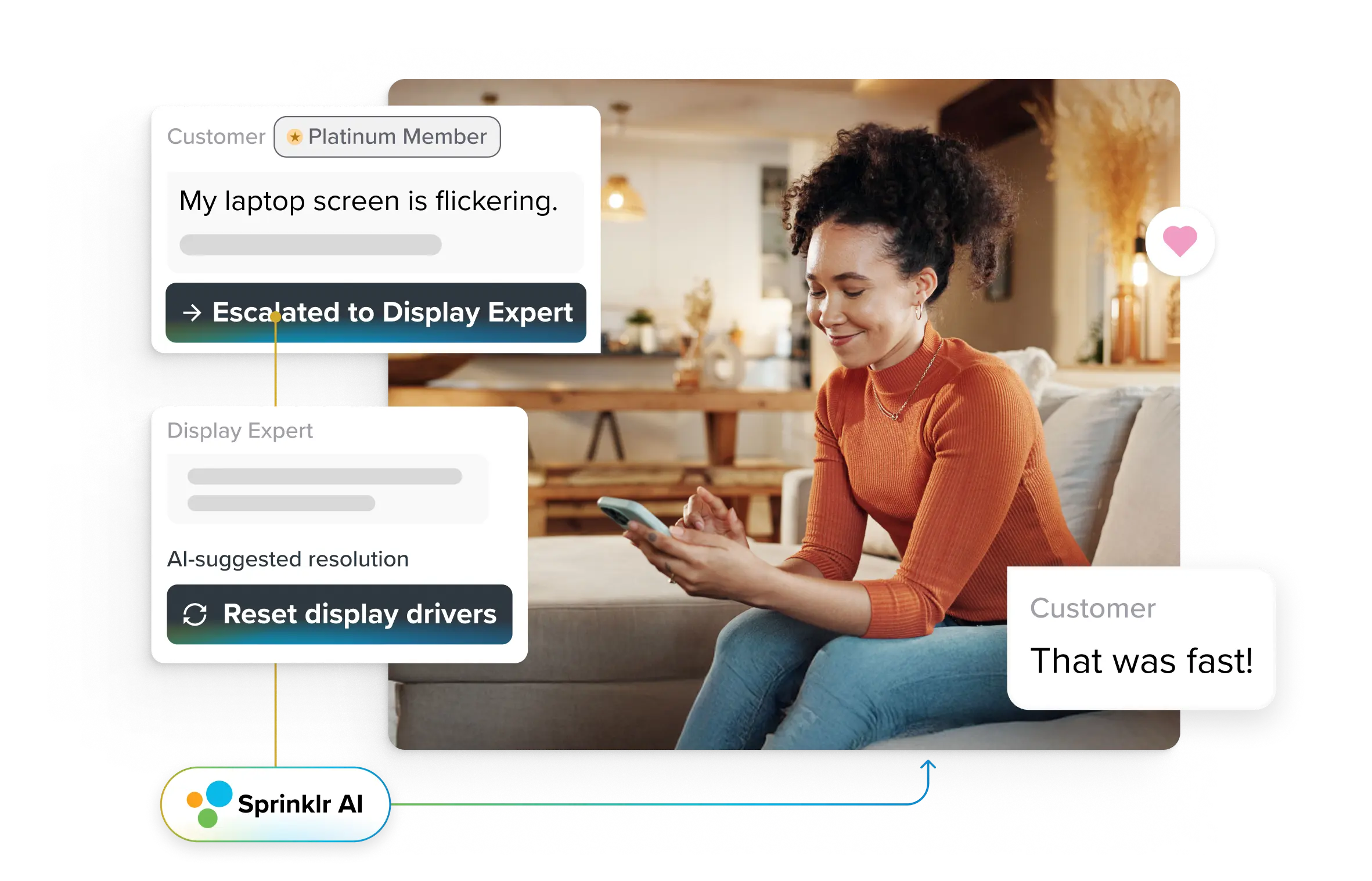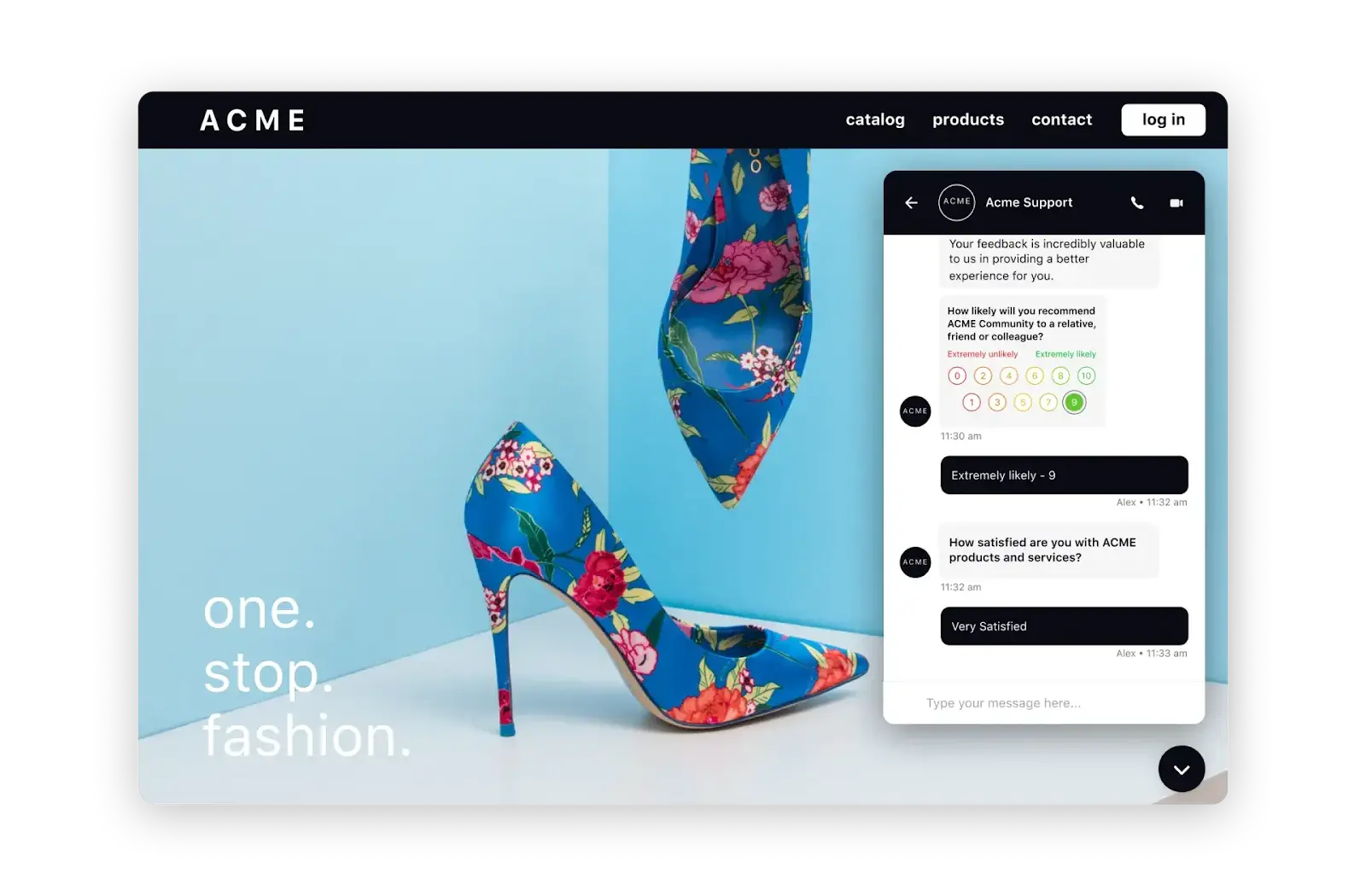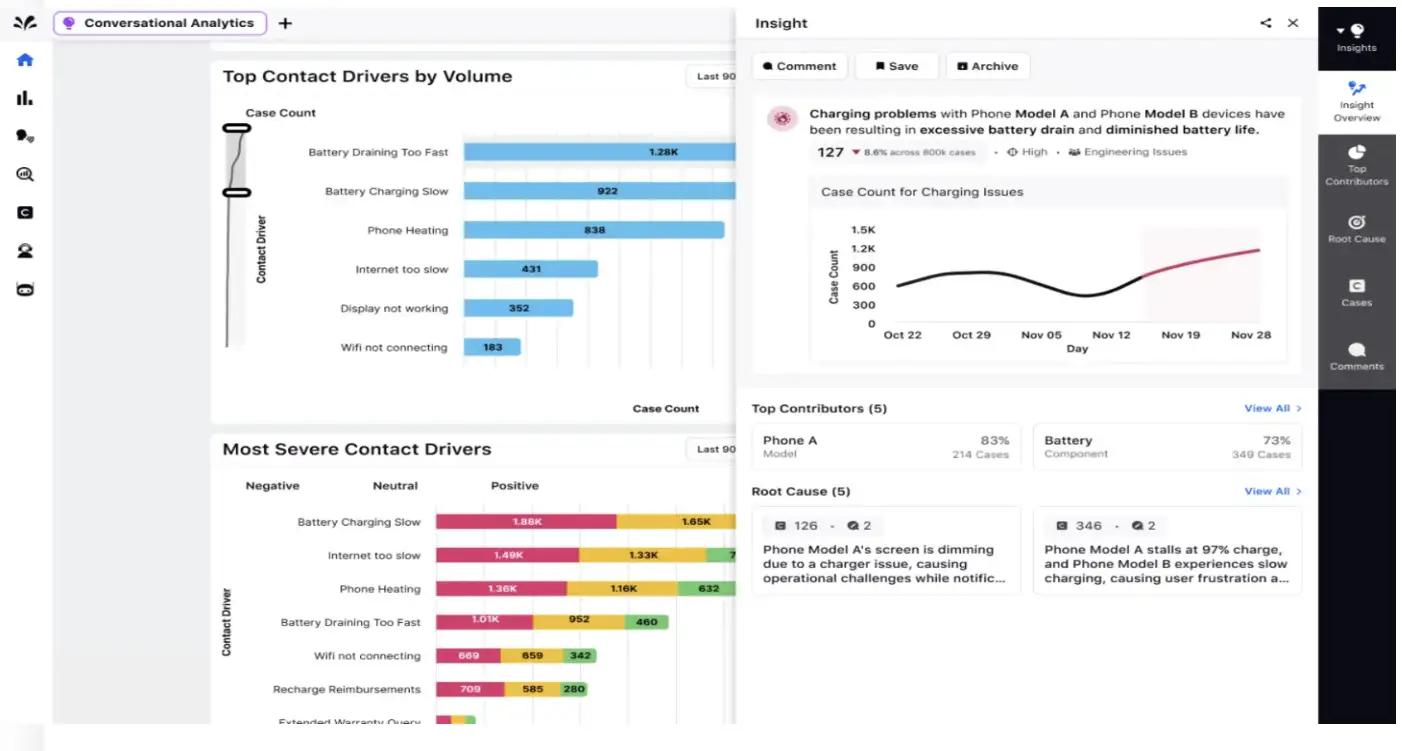Transform CX with AI at the core of every interaction
Unify fragmented interactions across 30+ voice, social and digital channels with an AI-native customer experience platform. Deliver consistent, extraordinary brand experiences at scale.

How to Identify and Prioritize Customer Needs [+Best Practices]
Have you ever considered what made Netflix the leader in the streaming service landscape?
There are many factors, but one stands out: Netflix understood customer needs in the entertainment industry first, better and deeper than anyone else. They recognized the growing demand for watching content anytime, anywhere and on any device. They tapped into the need for ad-free viewing and offered personalized content choices, all while delivering the ultimate convenience — personalized, on-demand entertainment right from the comfort of your couch.
While competitors have since tried to replicate Netflix’s model, its dominant position today is rooted in its unmatched ability to meet customer needs — even those customers didn’t know they had. The result? A revolutionary disruption in the industry with lasting rewards.
But what does it truly take to understand customer needs in your industry? Once you identify them, how do you prioritize them to drive business success?
Let’s find out.
What are customer needs?
Customer needs refer to consumers' essential desires or expectations when purchasing a product or service. These needs can range from basic functional requirements — like the durability of a pair of shoes — to emotional desires, such as feeling valued and appreciated by a brand. Understanding and addressing these needs is critical for any business aiming to thrive in a competitive market.
When you truly understand what your customers want, you gain the power to tailor your products, services and interactions to meet these expectations. This not only boosts customer satisfaction but also fosters customer loyalty and encourages repeat business, giving you a sense of control and confidence in your business decisions.
However, it's important to distinguish between customer needs and requirements. Customer needs are the underlying motivations and desires that drive purchasing behavior — often emotional and sometimes unspoken. On the other hand, customer requirements are specific, measurable attributes or features a product or service must offer to meet those needs. For example, a customer may need convenience, while the requirement could be an app feature that enables quick online ordering.
Understanding customer needs offers several significant benefits. It:
- Increases customer satisfaction: Meeting customer needs directly leads to delighted, loyal customers who are more likely to return and recommend your brand. Take Starbucks, for example. They excel in customer satisfaction by personalizing their offerings — allowing customers to customize drinks and benefit from a rewarding loyalty program.
- Boosts sales and revenue: Did you know that 89% of consumers are more likely to make another purchase after a positive customer service experience? Satisfied customers are likelier to make repeat purchases and spend more.
- Strengthens brand reputation: A deep understanding of customer needs signals that you are a customer-oriented brand. In today's marketplace — where product differentiation is becoming more challenging — this customer-centricity builds a strong, positive brand perception. It also strengthens your brand reputation management efforts, giving you an edge that's difficult for competitors to replicate.
- Offers competitive advantage: Understanding customer needs doesn’t just guide strategic decisions; it shapes your entire operational approach. For example, implementing a chatbot to handle common queries can transform a broad goal like "making customer service fast and easy" into reality. When customer focus becomes a core part of your operations, customer-centricity naturally becomes ingrained in your processes — leading to a sustainable, long-term competitive advantage.
9 Types of customer needs you should know about
Understanding diverse customer needs is like having a structured blueprint. It guides you to make your products and services stand out. Let’s examine the nine common customer needs to understand what your customers truly want:
1. Functionality
Customers expect your product or service to solve their problems or fulfill their desires. Smartphones, for example, should reliably provide call and internet services to meet different communication needs.
2. Price
Each customer has budget considerations. Offering products or services at different price points allows you to cater to various financial situations and preferences.
3. Convenience
Your product or service should make life easier for customers or streamline tasks. As an illustration, think of food delivery apps. They provide convenience by enabling users to order from their favorite restaurants effortlessly.
4. Experience
The user experience should be straightforward and pleasant. A well-designed app or website, for example, with an intuitive layout and responsive design, becomes easy to navigate, enhancing user satisfaction.
5. Reliability
Customers need your product or service to perform consistently and as promised. For instance, a dependable car that starts every time, even in inclement weather, helps build trust and confidence in its performance.
6. Performance
Your product or service should help customers achieve their goals efficiently. Brands that don’t meet performance standards cannot grow, even with successful marketing or customer service.
7. Empathy
Customers appreciate empathy when interacting with your service team. Providing compassionate and attentive support can significantly enhance customer satisfaction, especially when resolving issues.
8. Efficiency
Products or services should simplify processes and save customers’ time. For example, a project management tool that automates repetitive tasks can enhance efficiency by reducing manual work and boosting productivity.
9. Compatibility
Your product or service should unify seamlessly with other items customers already use. Imagine you buy a new printer. It should connect seamlessly with your existing computer systems and software.
How to identify and meet your customer needs
Now that you understand the various types of customer needs, let's explore some proven methods for identifying them.
1. Conduct surveys and share questionnaires
One of the most direct ways to identify customer needs is to gather feedback through customer surveys and questionnaires. Ask customers about their preferences, pain points and expectations, then analyze the data to uncover trends and recurring issues. These consumer insights allow you to make informed decisions about product improvements or introduce new offerings that align with customer demands.
However, survey fatigue is a real challenge.
If you notice lower response rates, rushed answers or even survey abandonment, your customers may be experiencing survey fatigue. This occurs when customers become disinterested due to the sheer volume of survey requests they receive. Here are a few strategies to counteract it:
✂️ Keep it short: The shorter the survey, the higher the completion rate. Keep an eye on the average time it takes to complete your survey — anything too long can drive respondents away.
❌ Avoid asking for personal information unnecessarily: This often leads to lower response rates as customers hesitate to share sensitive data.
💬 Run conversational surveys: Instead of traditional surveys, leverage modern omnichannel survey software that converts questions into engaging, conversational formats.
These surveys can be conducted via chatbots, making the process more natural and engaging for customers. Integrating conversational surveys on messaging channels can significantly boost response rates as well.
😊 Good to know
Sprinklr can help you effortlessly create interactive surveys tailored to your customers. By delivering surveys through the channels your customers already use — such as chat apps or social media — you can engage them in a conversational manner, reducing friction and improving response rates. You can also instantly analyze feedback and act in real-time with AI-driven insights.

2. Monitor social media
Monitoring social media platforms is essential for understanding what customers say about your brand, products and services in real time. By monitoring social mentions, comments and reviews, you can gain valuable insights that help you address concerns, answer questions and continually improve your offerings. But remember that it’s not just about reacting but proactively shaping the conversation.
📣 Did you know?
With today’s advanced social listening tools, you can tap into billions of customer conversations across 30+ social and digital channels. These platforms use AI to provide fast, accurate insights into customer sentiment, emotions and behavior. From identifying emerging trends to tracking brand sentiment in real-time, social listening gives you the power to understand how your customers feel about your brand — and act quickly to improve their experience.
Social listening also plays a critical role in preventing potential PR crises. By monitoring shifts in sentiment, you can take timely action to address negative feedback before it spirals into a larger issue, protecting both your brand reputation and customer loyalty.
3. Analyze customer data
One of the most effective methods for identifying customer needs is by analyzing the vast amount of data available from customer interactions, purchase history and website behavior. This data offers valuable insights into patterns, preferences and shifts in customer intent, helping you make informed decisions about product offerings and service experiences.
For instance, imagine noticing a trend where customers consistently purchase mojito syrup at the start of the holiday season and, soon after, buy cocktail glasses. You can create a bundled offer by recognizing this pattern — pairing the syrup with glasses as a holiday combo. This meets customers’ needs and enhances their experience by offering convenience and value at the right moment.
How Sprinklr helps
Sprinklr’s AI-powered solutions make it easier than ever to identify and meet customer needs by leveraging the full potential of your data. With Sprinklr’s Conversational AI software, you can analyze 100% of your customer conversations across various channels, helping you discover trending topics, customer intents and shifts in sentiment in real time.

But it doesn’t stop there — Sprinklr allows you to drill down into each contact driver to uncover the surface-level issues and root causes behind customer interactions. You’ll gain detailed insights into why customers are reaching out and actionable recommendations to address those needs effectively.
4. Build focus groups
Organize focus groups with diverse customer segments to gather detailed insights into their needs and expectations. This qualitative method allows for in-depth discussion and feedback. You can use this feedback to make targeted improvements to your products or services and to generate ideas for new offerings.
💡 Pro Tip: Ensure your focus group includes a mix of demographics to get a comprehensive view of customer needs. For example, if you're developing a new educational app, include students, parents and teachers from various ages and diverse backgrounds to understand different perspectives. Record the sessions (with permission) for accurate analysis and reference.
5. Utilize the customer community portal
An online community portal offers a direct line to your customers' opinions, allowing you to gather unfiltered insights. You can identify recurring pain points, product suggestions and emerging trends through discussions, polls and forums. This ongoing interaction gives you a richer understanding of customer needs than traditional methods like surveys or focus groups, which can be more static.
Communities often serve as breeding grounds for innovation. By listening to your most engaged customers, you can identify new product features or improvements that align with their evolving needs. These user-generated ideas can give your brand a competitive edge, as the community feels invested in co-creating the future of your product or service.
Tips to prioritize customer needs
Prioritizing customer needs is essential for keeping your customers happy and loyal. Here are four practical tips to help you prioritize what your customers want. Plus, we’ve got some dos, don’ts and best practices to ensure you achieve optimal results:
1. Deliver high-touch customer service
Providing high-touch customer service is crucial for effectively prioritizing customer needs. Start by ensuring your customer service channels are easily accessible and that your team is well-equipped to respond quickly and empathetically. Train your team that high-touch service isn’t just about solving problems; it’s about creating meaningful interactions that resonate with customers long after the issue is resolved.
Train your service reps to handle various customer service scenarios professionally and empathetically. When you understand customer pain points and deliver personalized, timely solutions, you build a genuine customer connection that builds trust and loyalty.
📌 Best practices
- Don’t leave customer inquiries unanswered, and steer clear of scripted responses that fail to address the root of the problem.
- Don’t let volume dictate the experience. If your contact center receives a high volume of inquiries, don’t sacrifice personalized service. Instead, use conversational AI to dynamically handle requests, manage interruptions and resume conversations seamlessly, all while maintaining a human-like experience.
- Implement a robust follow-up system to ensure swift issue resolution. After resolving a customer issue, follow up with a survey or a call to enhance satisfaction. A little attention goes a long way.
2. Utilize social media for quick service
Using social media channels for quick service can significantly enhance customer satisfaction. Monitor your social media platforms regularly for customer queries. Respond promptly and courteously to any concerns raised. Consider Amazon. If a customer tweets about a delayed delivery, the company quickly responds with an apology and an update on the shipment status, often within minutes.
📌Best practices
- Do not overlook negative comments or complaints and avoid using only automated responses that lack a personal touch. Keep in mind that consistent and timely interaction with your audience is crucial for addressing customer needs.
- Instill confidence in your customers by offering proactive customer service addressing potential issues before they escalate. Imagine you notice frequent complaints about a particular product feature. Proactively communicate improvements or offer solutions before customers become frustrated. Identify common problems and address them preemptively to ensure a secure and confident customer base.
Must Read: How to Implement Social Media Customer Service Successfully
3. Track customer journeys
Tracking the customer journey means mapping out every customer touchpoint and interaction a customer has with your business. Analyzing where customers are in their journey allows you to be proactive, not reactive. Whether they're in the research phase or approaching a buying decision, you can leverage historical data and predictive analysis to tailor your product or service offerings. This approach not only improves the customer experience but also boosts conversion rates by aligning your offerings with customer needs at each stage.
📌Best practices
- Leverage real-time customer interaction analytics to monitor and respond to customer behavior. Say website analytics reveal a high bounce rate on your webpage. Then, quickly investigate and make necessary adjustments to improve the browsing experience.
- Maximize your productivity and effectiveness by segmenting customer journeys to tailor your approach. Break down customer journeys by different segments, such as awareness, consideration and purchase. For instance, if data reveals that younger customers engage more with social media during the awareness stage, you can focus your marketing efforts on social media platforms to capture their attention.
- Implement automated alerts at critical touchpoints. Set up alerts for key stages in the customer journey where issues commonly occur. For example, if customers frequently abandon their shopping carts, an automated alert system can prompt a review of the checkout process and trigger targeted follow-up actions.
Don't Miss: Customer Journey Mapping: How to Do it in 5 Steps
4. Regularly review customer feedback
Regularly reviewing customer feedback is essential for staying aligned with your customer's evolving needs. Whether gathered through surveys, reviews, social media comments or direct interactions, feedback offers valuable insights into areas where your product or service can improve.
For instance, if multiple customers mention long hold times in their reviews, it signals a clear pain point. Implementing a scheduled callback feature through IVR can help address this issue and prevent customer frustration.
However, collecting, managing and analyzing feedback from multiple channels can become overwhelming as your business scales. Relying solely on manual tracking increases the risk of missing critical insights.
To avoid this, consider using AI-powered online survey tools that gather feedback and provide a 360° view by integrating data from social media, review sites and direct customer interactions. These solutions enable you to turn unstructured feedback into actionable insights, ensuring no feedback slips through the cracks.

📌 Best practices
- Set up a regular schedule to review and act on customer feedback. Review feedback as frequently as possible depending on the industry and the size of your business. A large e-commerce platform with a sizable team may review feedback daily, whereas a smaller company might find it more manageable to respond to reviews three or four times a week.
- Let customers know how their feedback has been implemented. Communicate changes based on customer suggestions through emails, newsletters or social media updates. For instance, if customers requested a new feature in the past, announce its launch and credit their input in a newsletter.
Put customer needs at the heart of your customer strategy
Identifying and prioritizing customer needs is one thing — implementing them is a whole different challenge. In an era of rapid digitization, where customer expectations are higher than ever, many businesses struggle to manage the overwhelming volume of interactions across multiple channels. This makes it increasingly difficult to derive actionable insights around core customer needs that truly enhance the experience.
Manual processes often fall short, leading to missed opportunities, unresolved pain points and a lack of personalized service. Whether it’s sifting through unstructured feedback or handling high query volumes, you’re not alone if keeping up with these demands feels like an uphill battle.
That’s where Sprinklr Service can make a difference. Powered by Sprinklr AI+, it analyzes 100% of your customer interactions, allowing you to identify and prioritize customer needs in real-time eliminating the guesswork. With AI-driven chatbots, sentiment analysis and predictive insights, Sprinklr empowers you to meet and anticipate your customer’s needs, delivering exceptional, personalized service that boosts loyalty and drives revenue growth.
To know more, schedule a demo of Sprinklr Service today!
Frequently Asked Questions
Businesses often assume past customer preferences will always hold. They may also rely too much on what worked in the past without validating it with current customer data. Common mistakes include not listening to customer feedback and failing to update one's understanding of customer needs.
By using data and technology, companies can meet individual needs while streamlining operations.
Industries with rapidly changing trends, like fashion or technology, can find it particularly challenging to keep up with evolving customer needs. In fashion, trends shift quickly due to cultural influences and seasonal changes, making it hard for businesses to keep up with customer demands. Similarly, innovations and products emerge frequently in technology. Such rapid changes mean customer expectations evolve quickly, requiring companies to stay agile.
Businesses can achieve this by providing personalized responses, offering regular updates and implementing tangible changes based on customer feedback.
Employee training is crucial as it equips staff with the skills to understand, respond to and anticipate customer needs effectively.










